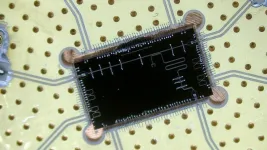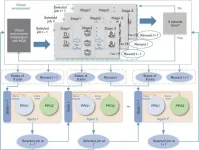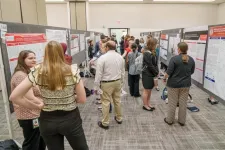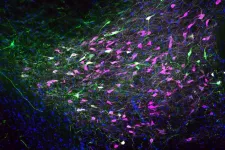Investigating how decision-making and behavioral control develop
Researchers characterized changes in the brain as people age and discovered that neural changes in teenagers may predict how decision-making and behavioral control develop.
2025-03-10
(Press-News.org) Many psychiatric disorders are linked to altered functioning of brain networks that drive reward processing and executive functions like making decisions, taking risks, planning, and memory. But a better understanding of how these networks typically develop to support reward-related executive functions is needed. New in JNeurosci, Samuel Klein and Monica Luciana, from the University of Minnesota, led a longitudinal study to explore how brain networks for reward processing and executive functioning change as people age.
The researchers assessed imaging data of over 150 people aged 11 to 25. They discovered changes in the strength of communication between brain regions in distinct networks from the teens into adulthood. These developmental network changes were associated with improved reward-related decision-making and executive function. In other words, “the specific networks that promote reward versus behavioral control differentiate themselves through the course of adolescence, which is a novel discovery,” says Luciana. According to the researchers, their observations advance our understanding of risk-taking teens and are informative for those studying how psychopathology develops, pointing to brain networks that may function differently in these individuals.
###
Please contact media@sfn.org for full-text PDF.
About JNeurosci
JNeurosci, the Society for Neuroscience's first journal, was launched in 1981 as a means to communicate the findings of the highest quality neuroscience research to the growing field. Today, the journal remains committed to publishing cutting-edge neuroscience that will have an immediate and lasting scientific impact, while responding to authors' changing publishing needs, representing breadth of the field and diversity in authorship.
About The Society for Neuroscience
The Society for Neuroscience is the world's largest organization of scientists and physicians devoted to understanding the brain and nervous system. The nonprofit organization, founded in 1969, now has nearly 35,000 members in more than 95 countries.
END
ELSE PRESS RELEASES FROM THIS DATE:
2025-03-10
The Camden Study, a pregnancy cohort of 4,765 women recruited between 1985 and 2006 from one of America’s poorest cities, has found new life at Rutgers University – where it promises to unlock critical insights into maternal and child health for researchers worldwide.
According to a recent paper in Nutrients, the project was designed to study nutritional status in adolescent pregnancies but expanded into a comprehensive repository of maternal and infant health data that yielded more than a decade of significant ...
2025-03-10
Currently more than 8,000 satellites are orbiting at altitudes of between 300 and 1000 km in the Earth’s upper atmosphere – also called the thermosphere. While changes in space weather, such as coronal mass ejections and solar flares, can cause temporary changes in the density of this region, scientists at the University of Birmingham suggest the effects caused by global warming are likely to be much longer term.
This is because of the effects caused by greenhouse gases (GHGs) ...
2025-03-10
MIT aerospace engineers have found that greenhouse gas emissions are changing the environment of near-Earth space in ways that, over time, will reduce the number of satellites that can sustainably operate there.
In a study that will appear in Nature Sustainability, the researchers report that carbon dioxide and other greenhouse gases can cause the upper atmosphere to shrink. An atmospheric layer of special interest is the thermosphere, where the International Space Station and most satellites orbit today. When the thermosphere contracts, the decreasing density reduces atmospheric drag— a force that pulls old satellites and other debris down to altitudes where they will ...
2025-03-10
A mysterious phenomenon at the centre of our galaxy could be the result of a different type of dark matter.
Dark matter, the mysterious form of unobserved matter which could make up 85% of the mass of the known universe, is one of science’s biggest manhunts.
In this first of its kind study, scientists have taken a step closer to understanding the elusive mystery matter. They believe a reimagined candidate for dark matter could be behind unexplained chemical reactions taking place in the Milky Way.
Dr Shyam Balaji, Postdoctoral Research Fellow at King’s College London and one of the lead authors of the study explains, “At the ...
2025-03-10
Phase transitions, like water freezing into ice, are a familiar part of our world. But in quantum systems, they can behave even more dramatically, with quantum properties such as Heisenberg uncertainty playing a central role. Furthermore, various spurious effects can cause the systems to lose, or dissipate, energy to the environment. When they happen, theses “dissipative phase transitions” (DPTs) push quantum systems into new states.
There are different types or “orders” of DPTs. First-order DPTs are like flipping a switch, causing abrupt jumps between states. ...
2025-03-10
A recent study published in Engineering presents a significant advancement in manufacturing scheduling. Researchers Xueyan Sun, Weiming Shen, Jiaxin Fan, and their colleagues from Huazhong University of Science and Technology and the Technical University of Munich have developed an improved proximal policy optimization (IPPO) method to address the distributed heterogeneous hybrid blocking flow-shop scheduling problem (DHHBFSP).
The DHHBFSP is a complex optimization challenge in manufacturing. In distributed manufacturing settings, jobs with diverse requirements arrive randomly at different hybrid flow shops. These shops have varying numbers of machines ...
2025-03-10
PHILADELPHIA – The American Association for Cancer Research (AACR) today announced its newly elected 2025 class of Fellows of the AACR Academy.
The mission of the Fellows of the AACR Academy is to recognize and honor extraordinary scientists whose groundbreaking contributions have driven significant innovation and progress in the fight against cancer. Fellows of the AACR Academy constitute a global brain trust of leading experts in cancer science and medicine, working to advance the AACR’s mission to prevent and cure all cancers through ...
2025-03-10
Student researchers from the Texas Tech University Health Sciences Center (TTUHSC) participated in the 37th Student Research Week Feb. 26-28. Organized by the TTUHSC Graduate School of Biomedical Sciences, Student Research Week is an opportunity for TTUHSC student investigators to showcase their work and hear presentations from distinguished national speakers related to the year’s theme.
The Department of Cell Physiology and Molecular Biophysics hosted the 2025 event. The Student Research Week committee chose “Let’s Get Biophysical” as the ...
2025-03-10
Ghent, Belgium, 10 March 2025 – New research from an international team of plant biologists, led by researchers at the VIB-UGent Center for Plant Systems Biology, has revealed crucial insights into the role brassinosteroids – essential plant hormones – play in regulating cell division and growth. The findings, published in Cell, provide a comprehensive understanding of how these hormones influence development at the cellular level.
Plants on steroids
Brassinosteroids are vital hormones for plants, which influence ...
2025-03-10
The opioid epidemic has claimed more than half a million lives in the U.S. since 1999, about three-quarters of them men, according to the National Institutes of Health. Although men’s disproportionate rates of opioid abuse and overdose deaths are well-documented, the reasons for this gender disparity are not well understood.
A new study in rats by researchers at Washington University School of Medicine in St. Louis suggests that one underlying cause may be biological. Male rats in chronic pain gave themselves increasing doses of an opioid – specifically, fentanyl – over ...
LAST 30 PRESS RELEASES:
[Press-News.org] Investigating how decision-making and behavioral control develop
Researchers characterized changes in the brain as people age and discovered that neural changes in teenagers may predict how decision-making and behavioral control develop.



